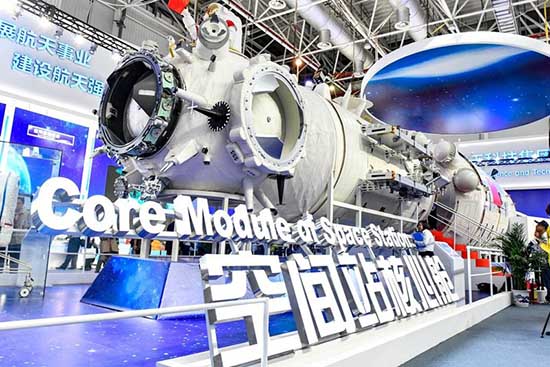2025年中国要在太空建发电站

|
中国探索宇宙的航天壮志正在飞向更高的轨道空间。 作为全球第二大经济体,中国一直在各方面努力提升自己的超级大国地位。继成功完成举世瞩目的探索月球背面之旅后,中国正准备在太空中建造一座太阳能发电站。中国航天项目的预算约为每年80亿美元,在全球仅次于美国。可以看出,中国正在经济、军事和科技领域与美国展开全方位的竞争。 目前,中国科学家已经开始在重庆建设相关实验基地。据官方媒体《科技日报》报道,中国的太空太阳能发电站计划将分为几个阶段,起步阶段是于2021年至2025年间在平流层建设一个小型发电站,第二阶段是2030年前在太空建造一座1兆瓦级的太阳能发电站,此后的阶段将陆续建造更多的空间发电设施。 那么,中国在航天领域已经取得了哪些成就呢? 探月 2019年1月3日,中国航天人首次将一个月球探测器成功降落在月球背面,这一壮举大大提振了中国航天事业的信心。由于月球背面不受地球电磁干扰,中国研发的嫦娥四号月球车能够更好地对月球展开相关科研活动。据中国官方媒体新华社报道,嫦娥四号搭载了一台低频射电频谱仪,能帮助科学家了解“最早的恒星是如何被点燃的,以及我们的宇宙在大爆炸后是如何从黑暗中出现的。” 第一棵植物在月球上发芽 看过科幻电影《火星救援》(The Martian)的观众想必还记得马特·达蒙在火星上种土豆的一幕。而在此次探月任务中,中国科学家也在测试荒凉的月球能否支持生命系统。据负责此次探月项目生物试验的重庆大学介绍,上个月嫦娥四号传回的图像显示,在有关试验启动9天后,嫦娥四号带去的棉花种子长出了第一枝嫩芽。此次嫦娥四号带去的生物学试验载荷包括棉花、油菜、土豆、酵母和果蝇。 更多任务 下一步,中国还将继续启动更多的探月任务。据中国国家航天局副局长吴艳华介绍,目前还有四个嫦娥探测器可能执行登月任务,其中至少两个将在月球的南极着陆。中国国家航天局还将探索在月球表面建立科研基地。另外,中国很有可能在2020年前后启动火星探测任务。 空间站 中国计划在2022年左右建成自己的空间站。该空间站被命名为“天宫”,它将由一个核心模块和两个用于科学实验的模块组成,总重约66吨,能够派驻三名宇航员,设计寿命至少为10年。该空间站将用于生物学、物理学和材料科学等十几个领域的科学研究。 允许私营企业参与火箭研发 中国国家主席习近平放松了政府对航天发射的管制,未来,中国很有可能形成一批足以与埃隆·马斯克的太空探索技术公司(Space Exploration Technologies Corp.)、杰夫·贝佐斯的蓝色起源公司(Blue Origin)和理查德·布兰森的维珍银河公司(Virgin Galactic)相匹敌的本土小型航天公司。这些初创公司已经获得了中国的风投资本和私募投资人的支持,同时也将能够获得中国航天项目专家的技术支持。 北斗 为了减少对美国掌控的GPS全球定位系统的依赖,中国耗资至少90亿美元建设了自己的卫星导航系统。众所周知,GPS是目前全球使用最广泛的定位系统,大到军用导弹,小到汽车、手机甚至你家宠物狗项圈里的芯片,使用的都是GPS的定位信号,而GPS的所有卫星都是由美国空军控制的,这自然令中国政府感到不安。因此,中国独立开发了北斗卫星定位系统,其定位精度能够达到1米以内。 太空垃圾 美国国防情报局本月表示,中国正在开发一些先进的太空技术,如“卫星检查与维修技术”和太空垃圾清理技术。该机构称:“至少其中的部分技术可作为针对美国卫星的武器”。中国外交部对此回应称,美方的指责是“毫无依据的”。(财富中文网) 译者:朴成奎 |
China’s space ambitions are shifting into a higher orbit. Following its successful and world-beating trip to the far side of the moon, China is preparing to build a solar power station in space, as the world’s No. 2 economy strives to burnish its superpower credentials. With an $8 billion annual budget for its space program, second only to the U.S., China is seeking to compete with its rival for economic, military and technological dominance. Scientists have already started construction of an experimental base in the western Chinese city Chongqing. Initially, they plan to develop a smaller power station in the stratosphere between 2021 and 2025, a 1 megawatt-level solar facility in space by 2030, and eventually larger generators, according to the state-backed Science and Technology Daily. Here’s what China’s been doing in space: Moon Exploration The nation’s space scientists successfully landed a lunar probe on the far side of the moon on Jan. 3, capping a series of missions and giving a boost to China’s ambitions. Landing on the unexplored region will enable Chang’e-4, the rover named after the mythical Moon Goddess, to better study the moon because of the lack of electromagnetic interference from Earth. The vehicle is equipped with a low-frequency radio spectrometer to help scientists understand “how the earliest stars were ignited and how our cosmos emerged from darkness after the Big Bang,” according to China’s official Xinhua News Agency. Green Shoots Reminiscent of the 2015 science fiction film “The Martian” starring Matt Damon, China’s lunar mission is also testing if the barren moon can support life. Pictures sent back from Chang’e-4 last month showed the first green leaf from cotton seeds nine days after the experiment was initiated, according to Chongqing University, which led the biological project. The test load on the mission carried cotton, canola, potato, yeast and fruit fly. More Missions China has more such missions in the pipeline. Four more versions of the Chang’e probe are in the offing, with at least two of them planned for a landing on the moon’s south pole, according to Wu Yanhua, vice administrator of the China National Space Administration. The agency will also explore setting up a research base on the moon. A Mars probe is likely by the end of this decade. Space Station China aims to build its own space station around 2022. Dubbed Tiangong, or Heavenly Palace, it will have a core module and two other modules for experiments, altogether weighing 66 tonnes and able to carry three people, with a designed life cycle of at least 10 years. The facility would be used for scientific research in a dozen areas including biology, physics and material sciences. Private Rockets President Xi Jinping has loosened the government’s monopoly on space launches, fueling the formation of small domestic companies with dreams of challenging companies such as Elon Musk’s Space Exploration Technologies Corp., Jeff Bezos’s Blue Origin and Richard Branson’s Virgin Galactic. The startups are receiving funding from China-based venture capitalists and private equity investors and can also rely on the expertise of rocket scientists from China’s space program. GPS Challenger Taking its rivalry with the U.S. to the heavens, China is spending at least $9 billion to build a navigation system and cut its dependence on the American-owned GPS — whose satellites beam location data used by smartphones, car navigation systems, the microchip in your dog’s neck and guided missiles. And, all those satellites are controlled by the U.S. Air Force, making the Chinese government uncomfortable. So, it has developed an alternative called the Beidou Navigation System, which eventually will provide positioning accuracies of 1 meter (3 feet) or less with use of a ground support system. Space Junk The Asian power is developing sophisticated space capabilities such as “satellite inspection and repair” and clearing up orbiting junk — “at least some of which could also function” as weapons against U.S. satellites, the U.S. Defense Intelligence Agency said this month. China’s Foreign Ministry has said the U.S. allegations were “groundless.” |













